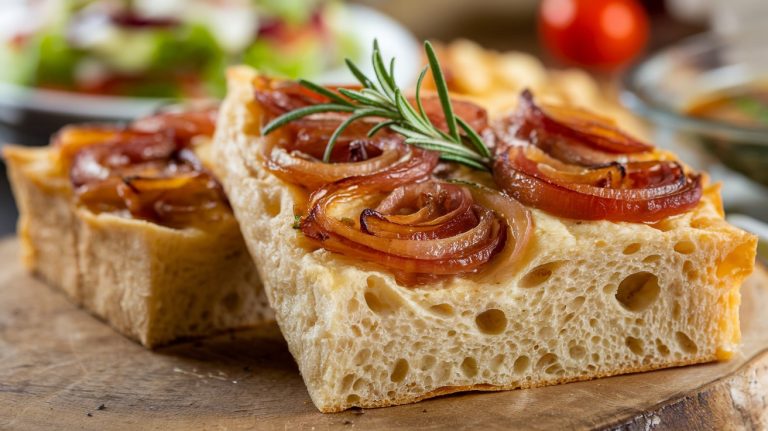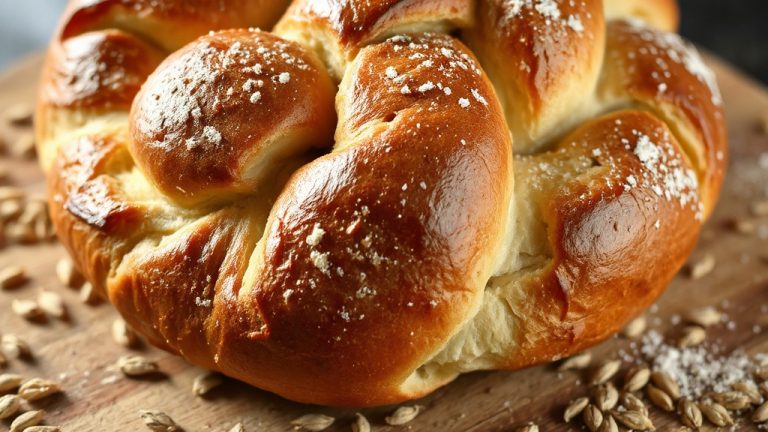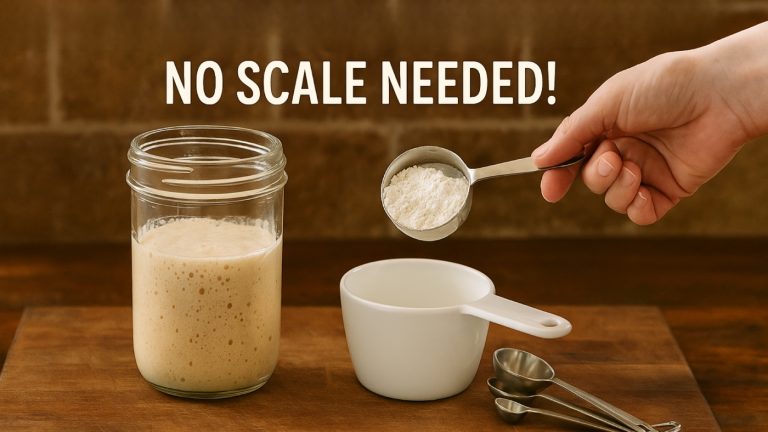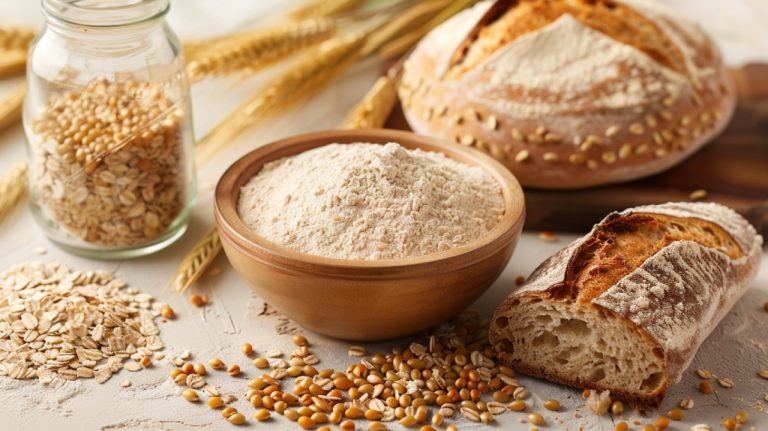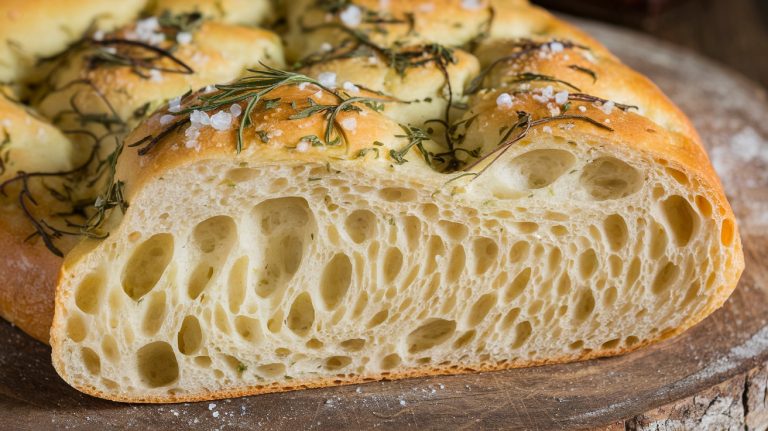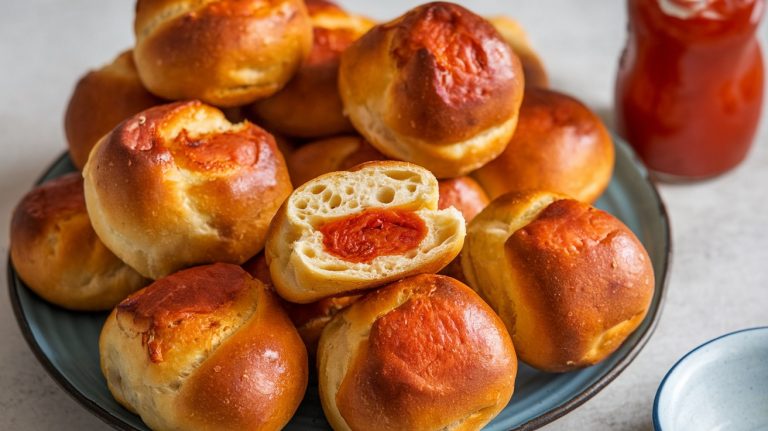Difference Between Ciabatta and Focaccia: Chewy or Soft?
Ciabatta and focaccia are distinct Italian breads that bring unique flavors and textures to the table. You’ll recognize ciabatta by its long, broad shape and chewy, airy interior, which is perfect for sandwiches.
Its thick, crusty exterior gives way to large air pockets. On the other hand, focaccia is a flatbread rich with olive oil, offering a softer, cake-like texture and versatility for toppings.
While ciabatta bakes at high temperatures for a rustic crust, focaccia bakes lower and faster for that dreamy softness. Curious about how these delightful breads can elevate your meals?
There’s so much more to explore!
Key Takeaways
- Ciabatta is a dense, chewy loaf with a thick crust, while focaccia is a flatbread with a light, cake-like texture.
- Focaccia is typically baked at lower temperatures on a sheet pan, whereas ciabatta is baked upright at higher temperatures.
- Focaccia has a higher hydration level (90%) compared to ciabatta (80%), affecting their respective textures.
- Focaccia often features various toppings and regional variations, while ciabatta maintains a simpler, rustic shape.
- Nutritionally, focaccia is higher in calories due to olive oil, while ciabatta has a lower fat profile and airy structure.
Characteristics of Ciabatta and Focaccia
When it comes to Italian bread, you might find yourself torn between ciabatta and focaccia, as each brings its own unique characteristics to the table.
Ciabatta is a long, broad loaf known for its dense, chewy texture and thick, crusty exterior. As you slice into it, you’ll notice the characteristic larger air pockets in the crumb, which contribute to its hearty feel.
On the other hand, focaccia is a flatbread that boasts a lightweight, cake-like consistency with a softer crust. Focaccia often retains more moisture, thanks to its higher olive oil content, enhancing its flavor and creating a rich, decadent texture.
A different baking method results in its uniform crumb, making it a delightful companion to various toppings and herbs. While both breads share basic ingredients like flour, water, and yeast, focaccia stands out with its added oil, providing a luxurious feel.
You’ll also find that ciabatta requires a longer baking time at higher temperatures, while focaccia cooks faster at lower temps, allowing for a versatile range of enjoyment.
Baking Techniques Comparison
Baking ciabatta and focaccia involves distinct techniques that highlight each bread’s unique qualities.
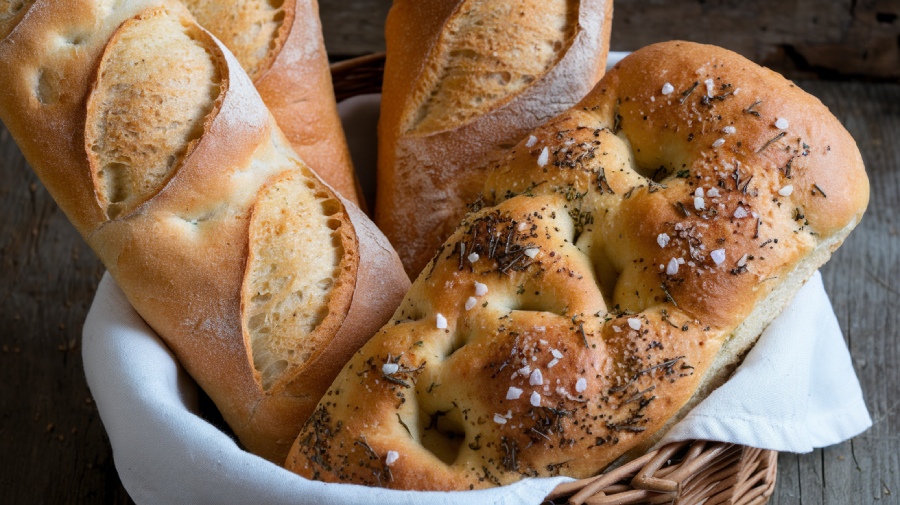
When you make focaccia, you typically bake it flat on a sheet pan, benefiting from lower temperatures and shorter baking times. This method, combined with the generous drizzle of olive oil in the dough, results in a softer crust.
In contrast, the dough for ciabatta is shaped into an elongated loaf and baked upright at higher temperatures. This approach allows for ideal crust development and a thicker, crusty exterior.
Focaccia generally requires a shorter proofing time, while ciabatta demands longer fermentation to achieve that airy crumb and larger air pockets.
The hydration levels also differ greatly; focaccia can reach up to 90%, creating a wetter, more cake-like consistency. Ciabatta, on the other hand, maintains around 80% hydration, contributing to its denser and chewier texture.
Before baking, you’ll often dimple focaccia to guarantee a uniform texture, while ciabatta’s rustic appearance is enhanced by its unique loaf shape.
Culinary Applications for Each Bread
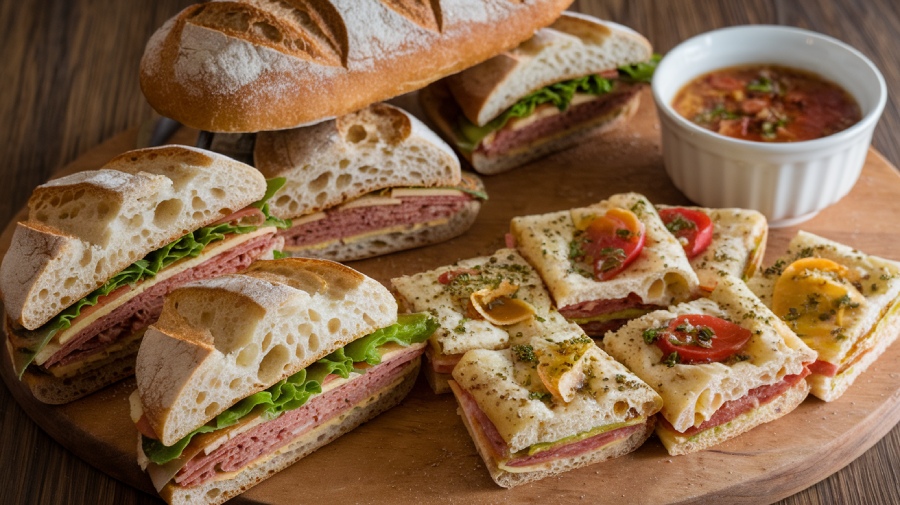
Focaccia and ciabatta each shine in their culinary applications, enhancing a variety of dishes with their distinct textures and flavors.
Focaccia is a versatile baked bread, often served as an antipasto or appetizer. You can enjoy it with dips, spreads, or as a delightful side to your meal. Its ability to be topped with various ingredients—like herbs, cheese, and vegetables—opens up endless possibilities for creative flavor combinations that can elevate any casual dining experience.
On the other hand, ciabatta is your go-to bread for hearty sandwiches and paninis. Its sturdy structure and chewy texture make it excellent for holding robust fillings without falling apart. The neutral flavor and airy crumb of ciabatta serve as a perfect canvas for showcasing rich meats, cheeses, and spreads, enhancing your overall dining experience. Imagine biting into a well-constructed sandwich where the ciabatta holds everything together beautifully.
Popular Varieties and Regional Differences
Across Italy, both focaccia and ciabatta boast a rich tapestry of regional varieties that showcase local ingredients and traditions.
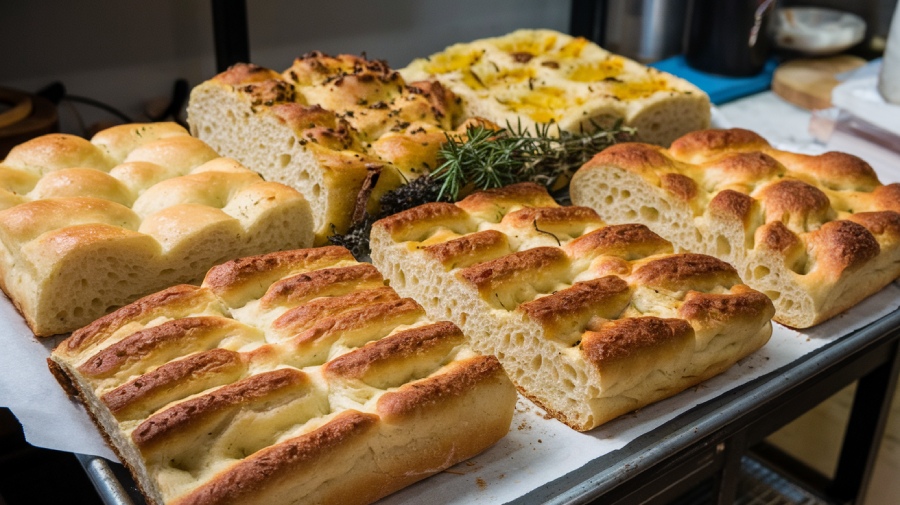
Focaccia stands out with adaptations like Focaccia Barese, which incorporates potatoes, and Focaccia di Recco, famous for its delectable cheese filling. You’ll find that focaccia is commonly associated with Italian gatherings, often topped with an array of ingredients that reflect seasonal produce and regional flavors.
On the other hand, ciabatta offers its own unique charm. While it maintains a consistent rustic loaf shape across regions, you can discover varieties like rustic ciabatta, which may feature whole grains or olives for an extra flavor kick.
Although ciabatta is typically favored for casual dining and making sandwiches, its versatility allows it to pair beautifully with various dishes.
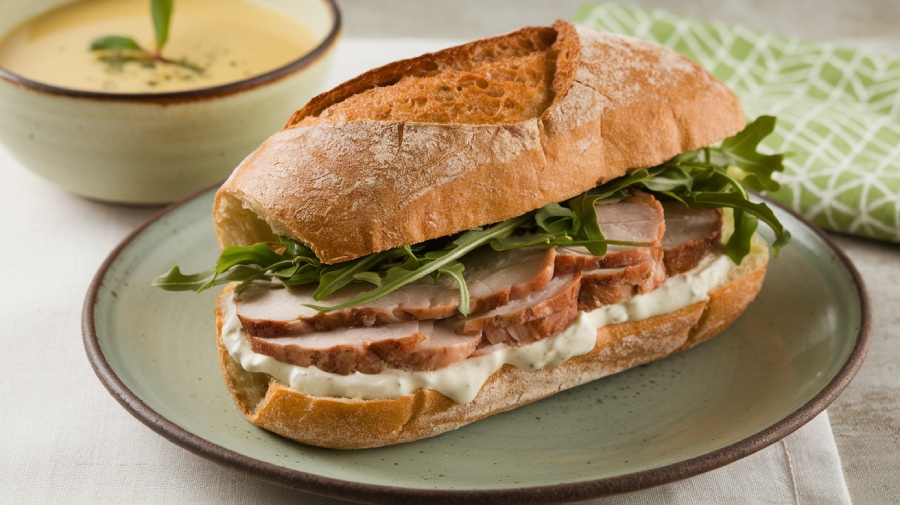
When you explore the regional differences, focaccia varies in thickness and toppings, with some areas preferring a thicker, herb-infused style.
In contrast, ciabatta keeps its traditional shape, emphasizing simplicity and crusty texture. Both types of bread reflect their Italian origins, enhancing your culinary experiences with each bite!
Nutritional Benefits and Considerations
Nutritional awareness plays a significant role when choosing between focaccia and ciabatta, as each bread offers distinct benefits and considerations.
Focaccia, often prepared with generous amounts of olive oil, typically has a richer calorie profile. This oil not only enhances flavor but also contributes to its higher fat content, making it a more indulgent option.
On the other hand, ciabatta is usually lower in fat, focusing on basic ingredients like flour, water, and yeast, which results in a lighter option regarding calorie density.
Both breads serve as excellent sources of carbohydrates, providing you with energy. However, focaccia’s higher hydration levels may lead to increased moisture content. Additionally, the toppings and herbs often added to focaccia can enhance its nutritional value, delivering vitamins and antioxidants.
In contrast, ciabatta’s airy structure may contribute to a lower calorie density per serving, depending on the specific recipe.
Ultimately, your choice hinges on your nutritional goals. If you’re seeking a richer flavor with added nutrients, focaccia might be your go-to. But if you prefer a lighter option, ciabatta could be the perfect fit.
Frequently Asked Questions
What Makes Ciabatta Bread Different?
Ciabatta bread stands out due to its unique shape and texture.
You’ll notice its long, flat form and airy, chewy crumb. The high-hydration dough, around 80%, creates those delightful air pockets that make each bite satisfying.
Its crust is thicker and crustier, providing a wonderful contrast to the soft interior. Baked upright at high temperatures, ciabatta develops a distinctive crust, making it perfect for sandwiches that need a sturdy, yet tender, base.
What Makes Focaccia Bread Different?
Imagine sinking your teeth into a warm, herb-infused slice of focaccia, where every bite is a delightful embrace of flavor.
Focaccia stands out due to its airy, cake-like texture and rich moisture. You’ll love how it’s often topped with ingredients like rosemary, olives, or tomatoes, turning it into a versatile dish.
Whether as a snack or sandwich base, focaccia’s unique characteristics make it a beloved choice in the world of bread.
What Bread Is Most Similar to Focaccia?
If you’re exploring breads similar to focaccia, schiacciata is a fantastic choice. This Tuscan flatbread shares a soft, moist interior with a deliciously crispy top, just like focaccia.
You’ll also find regional varieties across Italy, each boasting unique toppings and flavors.
Bread such as pizza bianca, with its herbed olive oil finish, can also remind you of focaccia’s delightful taste.
These breads make excellent meal companions or sandwich bases, adding versatility to your dining experience.
What Bread Is Most Similar to Ciabatta?
You might be surprised to learn that Pugliese bread has a similar chewy texture to ciabatta, making it a fantastic alternative.
With its open crumb and rustic appeal, Pugliese is often shaped round and boasts a slightly sweeter flavor due to different flours.
This bread’s crusty exterior and airy interior offer a delightful experience, perfect for sandwiches or dipping.
If you’re craving ciabatta, give Pugliese a try; it won’t disappoint!
Ciabatta vs. Focaccia: A Tale of Two Italian Classics
So, next time you reach for a slice of ciabatta, just remember—it’s not a fluffy pillow but rather a rustic canvas waiting for your toppings. And while focaccia may look like a golden-brown masterpiece, it’s really just a glorified flatbread, begging for attention with its herb-infused aroma.
Both breads have their charm, but choosing between them is like deciding whether to paint with a brush or a roller—each has its own delightful purpose in the culinary world.


